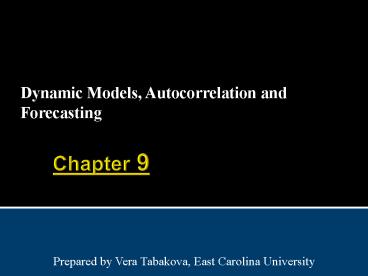Dynamic Models, Autocorrelation and Forecasting PowerPoint PPT Presentation
1 / 63
Title: Dynamic Models, Autocorrelation and Forecasting
1
Chapter 9
- Dynamic Models, Autocorrelation and Forecasting
Prepared by Vera Tabakova, East Carolina
University
2
Chapter 9 Dynamic Models, Autocorrelation and
Forecasting
- 9.1 Introduction
- 9.2 Lags in the Error Term Autocorrelation
- 9.3 Estimating an AR(1) Error Model
- 9.4 Testing for Autocorrelation
- 9.5 An Introduction to Forecasting
Autoregressive Models - 9.6 Finite Distributed Lags
- 9.7 Autoregressive Distributed Lag Models
3
9.1 Introduction
- Figure 9.1
4
9.1 Introduction
5
9.1 Introduction
- Figure 9.2(a) Time Series of a Stationary
Variable
6
9.1 Introduction
- Figure 9.2(b) Time Series of a Nonstationary
Variable that is Slow Turning or Wandering
7
9.1 Introduction
- Figure 9.2(c) Time Series of a Nonstationary
Variable that Trends
8
9.2 Lags in the Error Term Autocorrelation
- 9.2.1 Area Response Model for Sugar Cane
9
9.2.2 First-Order Autoregressive Errors
10
9.2.2 First-Order Autoregressive Errors
11
9.2.2 First-Order Autoregressive Errors
12
9.2.2 First-Order Autoregressive Errors
13
9.2.2 First-Order Autoregressive Errors
- Figure 9.3 Least Squares Residuals Plotted
Against Time
14
9.2.2 First-Order Autoregressive Errors
15
9.3 Estimating an AR(1) Error Model
- The existence of AR(1) errors implies
- The least squares estimator is still a linear and
unbiased estimator, but it is no longer best.
There is another estimator with a smaller
variance. - The standard errors usually computed for the
least squares estimator are incorrect. Confidence
intervals and hypothesis tests that use these
standard errors may be misleading.
16
9.3 Estimating an AR(1) Error Model
- Sugar cane example
- The two sets of standard errors, along with the
estimated equation are - The 95 confidence intervals for ß2 are
17
9.3.2 Nonlinear Least Squares Estimation
18
9.3.2 Nonlinear Least Squares Estimation
19
9.3.2a Generalized Least Squares Estimation
- It can be shown that nonlinear least squares
estimation of (9.24) is equivalent to using an
iterative generalized least squares estimator
called the Cochrane-Orcutt procedure. Details are
provided in Appendix 9A.
20
9.3.3 Estimating a More General Model
21
9.4 Testing for Autocorrelation
- 9.4.1 Residual Correlogram
22
9.4 Testing for Autocorrelation
- 9.4.1 Residual Correlogram
23
9.4.1 Residual Correlogram
- Figure 9.4 Correlogram for Least Squares
Residuals from Sugar Cane Example
24
9.4.1 Residual Correlogram
25
9.4.1 Residual Correlogram
- Figure 9.5 Correlogram for Nonlinear Least
Squares Residualsfrom Sugar Cane Example
26
9.4.2 A Lagrange Multiplier Test
27
9.4.2 A Lagrange Multiplier Test
28
9.5 An Introduction to Forecasting
Autoregressive Models
29
9.5 An Introduction to Forecasting
Autoregressive Models
- Figure 9.6 Correlogram for Least Squares
Residuals fromAR(3) Model for Inflation
30
9.5 An Introduction to Forecasting
Autoregressive Models
31
9.5 An Introduction to Forecasting
Autoregressive Models
32
9.5 An Introduction to Forecasting
Autoregressive Models
33
9.5 An Introduction to Forecasting
Autoregressive Models
34
9.5 An Introduction to Forecasting
Autoregressive Models
35
9.6 Finite Distributed Lags
36
9.6 Finite Distributed Lags
37
9.6 Finite Distributed Lags
38
9.7 Autoregressive Distributed Lag Models
39
9.7 Autoregressive Distributed Lag Models
- Figure 9.7 Correlogram for Least Squares
Residuals fromFinite Distributed Lag Model
40
9.7 Autoregressive Distributed Lag Models
41
9.7 Autoregressive Distributed Lag Models
- Figure 9.8 Correlogram for Least Squares
Residuals from Autoregressive Distributed
Lag Model
42
9.7 Autoregressive Distributed Lag Models
43
9.7 Autoregressive Distributed Lag Models
- Figure 9.9 Distributed Lag Weights for
Autoregressive Distributed Lag Model
44
Keywords
- autocorrelation
- autoregressive distributed lag models
- autoregressive error
- autoregressive model
- correlogram
- delay multiplier
- distributed lag weight
- dynamic models
- finite distributed lag
- forecast error
- forecasting
- HAC standard errors
- impact multiplier
- infinite distributed lag
- interim multiplier
- lag length
- lagged dependent variable
- LM test
- nonlinear least squares
45
Chapter 9 Appendices
- Appendix 9A Generalized Least Squares Estimation
- Appendix 9B The Durbin Watson Test
- Appendix 9C Deriving ARDL Lag Weights
- Appendix 9D Forecasting Exponential Smoothing
46
Appendix 9A Generalized Least Squares Estimation
47
Appendix 9A Generalized Least Squares Estimation
48
Appendix 9A Generalized Least Squares Estimation
49
Appendix 9A Generalized Least Squares Estimation
50
Appendix 9B The Durbin-Watson Test
51
Appendix 9B The Durbin-Watson Test
52
Appendix 9B The Durbin-Watson Test
53
Appendix 9B The Durbin-Watson Test
- Figure 9A.1
54
Appendix 9B 9B.1 The Durbin-Watson Bounds Test
- Figure 9A.2
55
Appendix 9B 9B.1 The Durbin-Watson Bounds Test
- The Durbin-Watson bounds test.
- if the test is inconclusive.
56
Appendix 9C Deriving ARDL Lag Weights
57
Appendix 9C 9C.1 The Geometric Lag
58
Appendix 9C 9C.1 The Geometric Lag
59
Appendix 9C 9C.1 The Geometric Lag
60
Appendix 9C 9C.1 The Geometric Lag
61
Appendix 9C 9C.2 Lag Weights for More General
ARDL Models
62
Appendix 9D Forecasting Exponential Smoothing
63
Appendix 9D Forecasting Exponential Smoothing
- Figure 9A.3 Exponential Smoothing Forecasts for
two alternative values of a

